Hind’s Variable Nebula is a variable nebula located 400 light-years away in the constellation Taurus. The nebula is about 4 light-years across. It is illuminated by the young pre-main sequence star T Tauri. It has the designation NGC 1555 in the New General Catalogue and is also catalogued as Sh2-238 and HH 155.
Hind’s Nebula is a Herbig-Haro object, a bright patch of nebulosity in which new stars are forming. Visually, it changes in apparent size and magnitude over weeks and months. It varies in brightness because of material that occasionally comes between it and the variable star T Tauri. Observations with the Chandra X-ray Observatory yielded an apparent diameter of 5.98 arcseconds for the nebula.
The star and the nebula are part of the Taurus-Auriga complex, one of the nearest low-mass star forming regions to the Sun. T Tauri is a member of the Taurus-Auriga association, a young stellar association whose members are less than 2 million years old.
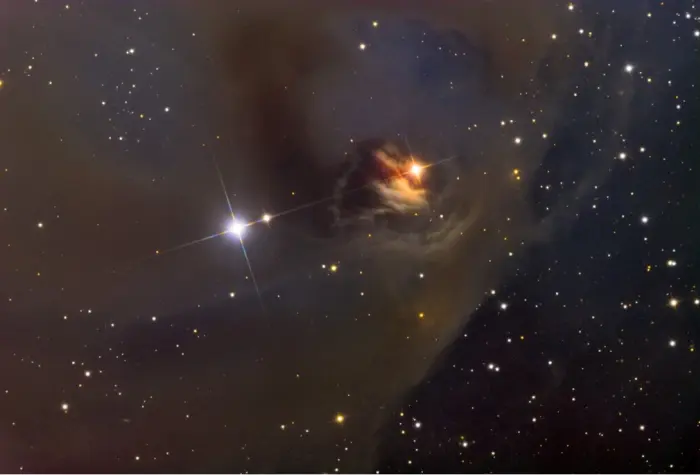
Hind’s Variable Nebula (NGC 1555), image credit: Adam Block/Mount Lemmon SkyCenter/University of Arizona (CC BY-SA 3.0)
Variable nebulae vary in brightness because they are illuminated by variable stars. The light of the central stars is periodically obscured, causing changes in the overall appearance of the nebulae. The spectra of these nebulae are very similar to those of the stars that illuminate them.
The yellowish star T Tauri is a prototype for a class of stars known as the T Tauri variables. T Tauri stars are variable stars less than 10 million years old that lie near molecular clouds and are still in the process of contracting to the main sequence. They are pre-main sequence stars with masses of less than 2 solar masses. Our Sun itself was a T Tauri star when it was still accreting material from its parent cloud. All Sun-like stars pass through this phase before they start fusing hydrogen on the main sequence.
T Tauri is composed of three stars, T Tauri North, T Tauri South A, and T Tauri South B. T Tauri North is separated by about 300 astronomical units (AU) from the T Tauri South binary star, and the components of T Tauri South are separated by around 7 AU. The individual components have masses of about 2.1, 2.12 and 0.53 solar masses, respectively.
Even though it is the prototype for the class of T Tauri variables, T Tauri North is believed to still be a protostar that was ejected from its dense birth cloud in the last few thousand years. It is a very young stellar object that is still in the early stages of formation. It has the spectrum of a Classic T Tauri star but it is in an earlier evolutionary stage.
Stars in this stage can normally be detected in infrared observations, which pierce through the thick surrounding gas and dust. They cannot be seen visually because they are still embedded in the dense clouds of dust in which they formed. The accretion disk of T Tauri North is aligned almost perpendicular to our line of sight, making the star visible in optical light.
T Tauri South can be observed mainly in the infrared band. The binary system is surrounded by a thick disk that blocks the optical light of the young stars. The system varies dramatically in brightness in the infrared, likely because the material in the circumbinary disk is not uniform. The brightness variations may also be due to the components flaring up as they accrete matter.
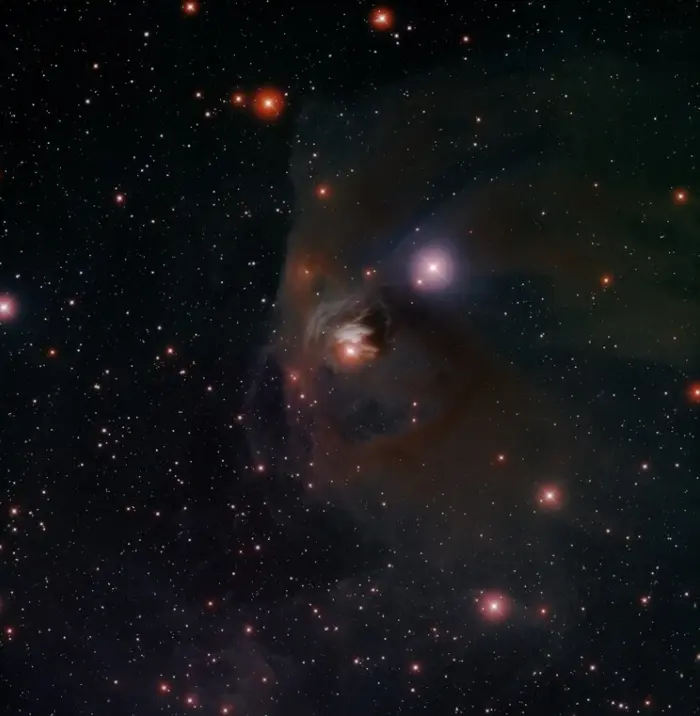
T Tauri is a famous variable star in the constellation of Taurus. In this image, it is the star at the center of the image, embedded in dust and gas. The nebula itself is known as NGC 1555. T Tauri is the prototype for a class of stars (known collectively as “T Tau stars”) that are notable because they are very young stars in the process of forming. These stars have just recently emerged from the dense dust and gas “cocoons” from which they formed. Image credit: T. A. Rector/University of Alaska Anchorage, H. Schweiker/WIYN and NOIRLab/NSF/AURA (CC BY 4.0)
Hind’s Variable Nebula appears west of T Tauri. It is the most prominent of three Herbig-Haro objects associated with the young star system. The cloud associated with Hind’s Nebula also includes dark nebulosity. It is catalogued as Cederblad 32b (Ced 32b), Sh2-238, GC 839, and HH 155.
Most of the surrounding cloud is dark and only a small fraction of the nebula is illuminated by T Tauri.
The Herbig-Haro objects associated with T Tauri also include HH 25 and HH 255 (Burnham’s Nebula, Cederblad 32c).
Burnham’s Nebula was discovered by American astronomer Sherburne Wesley Burham in 1890. It is formed by the interacting outflows from the young stars and the shock wave produced by their strong stellar winds. Like NGC 1555, it varies in brightness and morphology.
Burnham discovered the nebula using the 36’’ Great Lick Refractor. He was looking for Hind’s Nebula at the time, but could not find it and asked Edward Emerson Barnard, his colleague at the Lick Observatory in California, to take a look. Barnard found a nebula, which was called Barnard’s Nebula for a time, until astronomers realized that it was in fact Hind’s Variable Nebula. This was the first Herbig-Haro object to be discovered, even though the class was not defined until 1953.
The third Herbig-Haro object associated with T Tauri was discovered by Otto Wilhelm von Struve in 1868, but it has not been seen since the 19th century. It is known as Struve’s Lost Nebula and catalogued as NGC 1554.
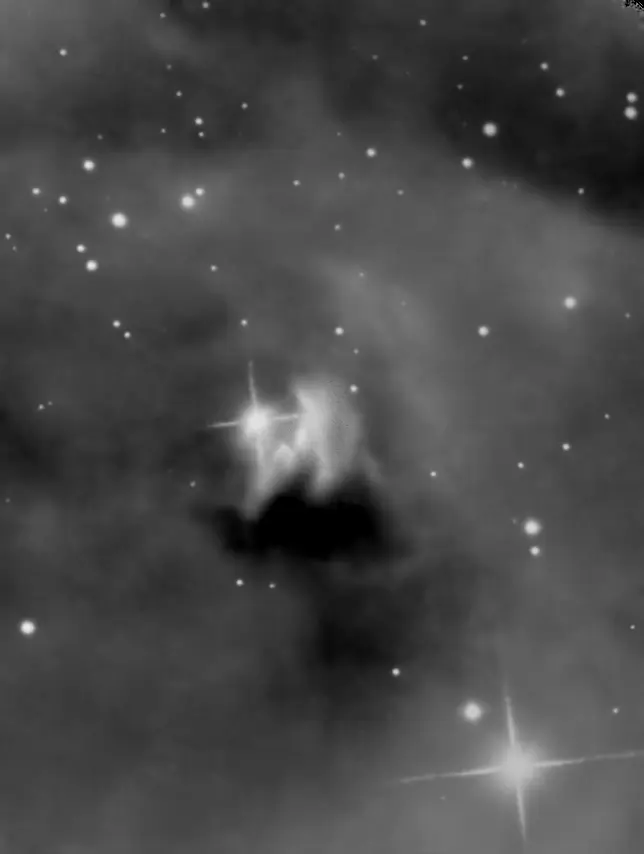
Timelapse of NGC1555 variable nebula activity over approximately 6 months through Oct 2022 to March 2023, using data from contributors of the Big Amateur Telescope, image credit: Wikimedia Commons/Danreind (CC BY-SA 4.0)
Facts
Hind’s Variable Nebula was named after the English astronomer John Russell Hind, who discovered it on October 11, 1852. It was the first nebula confirmed to vary in brightness. The nebula disappeared from view in the 1860s and underwent several dimming events in the late 1800s and early 1900s.
Hind’s Nebula is not to be confused with Hubble’s Variable Nebula (NGC 2261, Caldwell 46) in the constellation Monoceros (the Unicorn). Hubble’s Variable Nebula lies 2,500 light-years away and is illuminated by the young binary star R Monocerotis. Unlike T Tauri, R Monocerotis is a pre-main sequence star. It is a Herbig Ae/Be star, a more massive young stellar object that is still accreting material and is surrounded by an orbiting disk of dust and gas.
Other variable nebulae include McNeil’s Nebula in the constellation Orion and the R Coronae Australis Nebula (NGC 6729, Caldwell 68) in Corona Australis. Struve’s Lost Nebula near Hind’s Variable Nebula may also be one of them.
Struve’s Nebula (NGC 1554) was discovered by the Baltic German astronomer Otto Wilhelm von Struve in 1868 and later confirmed by the German astronomer Heinrich Louis d’Arrest in 1855-1856.
In October 1861, d’Arrest found the nebula missing. Even though it is included in the New General Catalogue, Struve’s Lost Nebula has not been observed since the 19th century. At Struve’s coordinates – 4 arcminutes west-southwest of T Tauri – there is only a 14th magnitude star. The nebula may have been a portion of the reflection nebula complex around T Tauri, or it may be illuminated by a variable star that only flares up rarely.
Danish astronomer John Louis Emil Dreyer included both NGC 1554 and NGC 1555 in his New General Catalogue of Nebulae and Clusters of Stars (1888). Dreyer himself was unable to find Struve’s Nebula with Lord Rosse’s 6-foot reflector telescope in 1877, but he included it based on Struve’s and d’Arrest’s previous observations.
Location
Hind’s Variable Nebula lies in the northern celestial hemisphere, in the region between Aldebaran and the Pleiades in the constellation of Taurus. It appears in the same area of the sky as the Hyades, about 1.7 degrees west-northwest of the star Ain (Epsilon Tauri), which marks one of the Bull’s eyes. Even though it appears in the same line of sight as the cluster, the nebula is not physically associated with it. It lies at a much greater distance.
The Hyades and the bright Aldebaran can be found by extending a line through the three bright stars of Orion’s Belt – Alnitak, Alnilam and Mintaka – to the northwest.
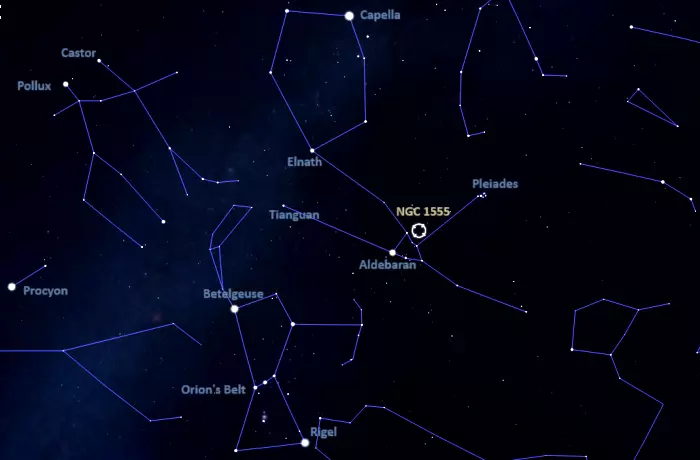
The location of Hind’s Variable Nebula (NGC 1555) in Taurus, image: Stellarium
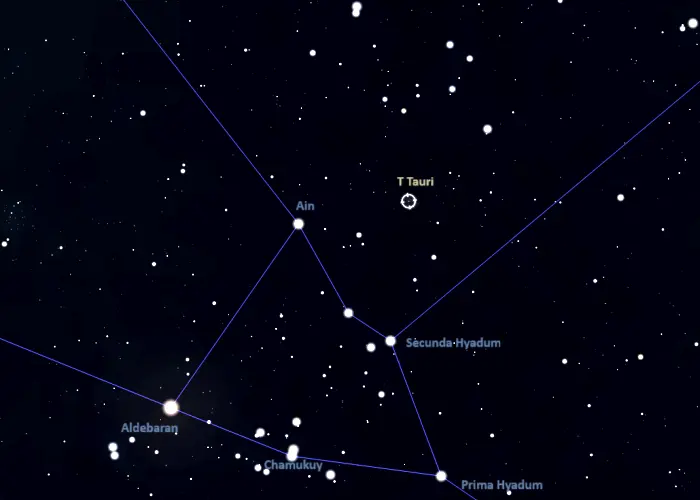
The location of T Tauri and NGC 1555, image: Stellarium
Hind’s Variable Nebula is a popular target for amateur astronomers and astrophotographers. It is best observed in large instruments at high magnification, with a nebula filter.
Hind’s Nebula and other deep sky objects in the constellation Taurus can be observed from September to February. The best time of the year to observe them is during the month of January, when Taurus appears high above the horizon in the evening.
Hind’s Variable Nebula – NGC 1555
| Constellation | Taurus |
| Right ascension | 4h 21m 57.1s |
| Declination | +19° 32′ 07″ |
| Apparent magnitude (B) | 9.98 |
| Distance | 400 light-years |
| Diameter | 4 light-years |
| Names and designations | Hind’s Variable Nebula, Hind’s Nebula, NGC 1555, Sharpless 238 (Sh2-238), HH 155, Cederblad 32b |